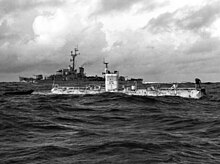Mariana Trench

The Mariana Trench (or Marianas Trench) is the deepest part of the world's oceans, and the deepest location on the surface of the Earth's crust. It has a maximum depth of about 10,911 meters[1] (35,798 feet; 6.78 miles), and is located in the western North Pacific Ocean, to the east and south of the Mariana Islands, near Guam.
The trench forms the boundary between two tectonic plates, where the Pacific Plate is subducted beneath the small Mariana Plate. At the bottom, the water column above exerts a pressure of 108.6 MPa, over one thousand times the standard atmospheric pressure at sea level. The creatures that could live at these depths are few, but some fish species, like the angler fish or other deep-sea fishes, have been spotted in these waters.[citation needed] To illustrate the depth of the Mariana Trench, consider this; if Mount Everest, which is the tallest point on earth at 8,850 meters (29,035 feet), were set in the Mariana Trench, there would still be 2,183 meters (7,166 feet) of water left above it.[2]
Measurement and study

The trench was first sounded during the HMS Challenger expedition (December 1872 – May 1876), which recorded a depth of 31,614 feet (9,636 m).
Guam and Saipan are part of the Mariana Islands, Tano Chamorro. In 1951, the Royal Navy vessel Challenger II surveyed the trench using echo sounding, a much more precise and vastly easier way to measure depth than the sounding equipment and drag lines used in the original expedition. During this survey, the deepest part of the trench was recorded when the Challenger II measured a depth of 5,960 fathoms (10,900 metres, 35,760 ft) at 11°19′N 142°15′E / 11.317°N 142.250°E.[3], known as the Challenger Deep.[2]
In 1957, the Soviet vessel Vityaz reported a depth of 11,034 meters (36,200 ft), dubbed the Mariana Hollow.[4] (Although this claim was made by the Soviets in 1957, the finding has not been repeated by subsequent mapping expeditions using more accurate and modern equipment. [citation needed])
In 1962, the surface ship M.V. Spencer F. Baird recorded a maximum depth of 10,915 meters (35,840 ft), using precision depth gauges. [5]
In 1984, the Japanese sent the Takuyō (拓洋), a highly specialized survey vessel, to the Mariana Trench and collected data using a narrow, multi-beam echo sounder; they reported a maximum depth of 10,924 meters, also reported as 10,920 meters ± 10 meters.[3][6]
The most accurate measurement on record was taken by a Japanese probe, Kaikō (かいこう), which descended unmanned to the bottom of the trench on March 24, 1995 and recorded a depth of 10,911 meters (35,798 ft).[1]
Descents
This article needs to be updated. (January 2009) |

The Swiss designed, Italian built, United States Navy bathyscaphe Trieste reached the bottom at 1:06 p.m. on January 23, 1960, with U.S. Navy Lieutenant Don Walsh and Jacques Piccard on board.[2] Iron shot was used for ballast, with gasoline for buoyancy.[2] The onboard systems indicated a depth of 11,521 meters (37,799 ft), but this was later revised to 10,916 meters (35,813 ft).[citation needed] At the bottom, Walsh and Piccard were surprised to discover soles or flounder about 30 cm (1 ft) long,[7] as well as shrimp.[citation needed] According to Piccard, "The bottom appeared light and clear, a waste of firm diatomaceous ooze".[7]
The Woods Hole Oceanographic Institution is planning to send its Nereus hybrid remotely operated vehicle (HROV) to explore the trench.[8]
See also
References
- ^ a b "Japan Atlas: Japan Marine Science and Technology Center". Retrieved 2007-07-04.
- ^ a b c d "The Mariana Trench - Oceanography". marianatrench.com. Retrieved 2009-02-25. Cite error: The named reference "marianatrench.com" was defined multiple times with different content (see the help page).
- ^ a b Ritchie, Steve. "The deepest depths". Retrieved 2007-07-04.
- ^ "Mariana Trench". Encyclopædia Britannica. Encyclopædia Britannica.
{{cite encyclopedia}}:|access-date=requires|url=(help) - ^ The deepest depths
- ^ "New Chief Hydrographer of Japan". Retrieved 2007-07-04.
- ^ a b National Oceanic and Atmospheric Administration (NOAA) webpage. Section "1960 - Man at the Deepest Depth"
- ^ Vessels and vehicles of the Woods Hole Oceanographic Institution
11°21′N 142°12′E / 11.350°N 142.200°E
External links
- Ocean Explorer (http://www.oceanexplorer.noaa.gov) - Public outreach site for explorations sponsored by NOAA's Office of Ocean Exploration & Research.
- NOAA, Ocean Explorer Mariana Arc - A rich collection of images, video, audio and podcast.
- NOAA, Ocean Explorer YouTube Ring of Fire Explorations Playlist 2004-2006
- NOAA, Ocean Explorer Google Map
- Mariana Trench on maps.google.com
